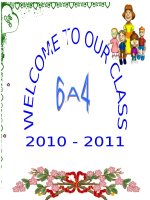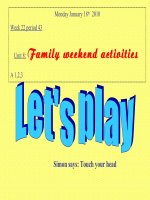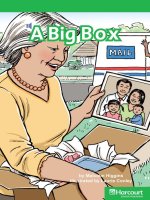- Trang chủ >>
- Mầm non - Tiểu học >>
- Lớp 5
5 2 2 a safe heaven (social studies)
Bạn đang xem bản rút gọn của tài liệu. Xem và tải ngay bản đầy đủ của tài liệu tại đây (4.95 MB, 14 trang )
Suggested levels for Guided Reading, DRA,™
Lexile,® and Reading Recovery™ are provided
in the Pearson Scott Foresman Leveling Guide.
A Safe Haven
by Lara Bove
Genre
Narrative
Nonfi
ction
nonfiction
Comprehension
Skills
Skill and
and Strategy
Strategy
• First
Author’s
ItemPurpose
• Graphic
Second Item
Sources
• Monitor and Fix Up
Text Features
•
•
•
•
Headings
Item 1
Captions
Item 2
Time
Item 3Line
Chart
Item 4
Scott Foresman Reading Street 5.2.2
ISBN 0-328-13522-4
ì<(sk$m)=bdfc g< +^-Ä-U-Ä-U
Reader Response
1. What do you think was the author’s purpose in
writing this book? Cite at least one paragraph that
supports that purpose.
A Safe Haven
by Lara
Bove
2. Go back to pages 6–9,
which
tell about the voyage
of the Henry Gibbins. What did you learn about the
voyage? What more would you like to know about it?
Use a graphic organizer like the one below to write
down your answers.
What I Learned
What I Want to Know
3. Show that you know the meaning of the word kosher
by using it in a sentence of your own.
4. The time line on page 3 mentions events that were
critical to this story. Do you think that any one event
was more important than the others? If so, why?
Editorial Offices: Glenview, Illinois • Parsippany, New Jersey • New York, New York
Sales Offices: Needham, Massachusetts • Duluth, Georgia • Glenview, Illinois
Coppell, Texas • Ontario, California • Mesa, Arizona
Every effort has been made to secure permission and provide appropriate credit for
photographic material. The publisher deeply regrets any omission and pledges to
correct errors called to its attention in subsequent editions.
Unless otherwise acknowledged, all photographs are the property of Scott Foresman,
a division of Pearson Education.
Photo locators denoted as follows: Top (T), Center (C), Bottom (B), Left (L), Right (R),
Background (Bkgd)
Cover: United States Holocaust Museum; 1–14 (C) United States Holocaust Museum;
15 (BL)© DK Images, (BC) United States Holocaust Museum; 16 (BL) United States
Holocaust Museum, (C) Getty Images; 17 United States Holocaust Museum;
18 (C) Imperial War Museum/©DK Images, (BL) Reg_Speller/Getty Images;
19, 20 United States Holocaust Museum; 21 (BL) Getty Images, (BR) United States
Holocaust Museum; 22 (C) United States Holocaust Museum, Getty Images,(B);
23 United States Holocaust Museum
ISBN: 0-328-13522-4
Copyright © Pearson Education, Inc.
All Rights Reserved. Printed in the United States of America. This publication is
protected by Copyright, and permission should be obtained from the publisher
prior to any prohibited reproduction, storage in a retrieval system, or transmission
in any form by any means, electronic, mechanical, photocopying, recording, or
likewise. For information regarding permission(s), write to: Permissions Department,
Scott Foresman, 1900 East Lake Avenue, Glenview, Illinois 60025.
2 3 4 5 6 7 8 9 10 V0G1 14 13 12 11 10 09 08 07 06 05
People in Danger
During World War II, many people were trying to leave
Europe. They were escaping from the German armies
that were taking over Europe. Adolf Hitler, the leader of
the Nazi party, became the ruler of Germany in 1933. He
believed that Jewish people, handicapped people, Gypsies,
and other groups of people were “inferior.” Hitler wanted to
eliminate all of these people, especially the Jews. As soon as
he took power, he began making laws that took away their
civil and legal rights. Then, in 1939, Hitler had his armies
invade Poland, provoking England and France to declare
war on Germany. World War II had begun.
The Nazis invaded and attacked most of Europe. In each
country they conquered, they tried to round up and kill all the
“inferior” people, in what became known as the Holocaust.
To avoid becoming victims of the Holocaust, many people
needed to escape from Europe as soon as they could.
1933 Adolf Hitler comes to power in Germany. He immediately
begins taking away the civil and legal rights of Jewish people.
1939 The Nazis invade Poland; World War II begins.
1942 The American government learns about the Holocaust.
1944 The War Refugee Board is created by President Roosevelt
to help European refugees.
3
Working for Change
Many refugees wanted to come to the United States. In
1938 more than 300,000 German refugees applied to enter
the country. However, many of them were prevented from
entering due to the U.S. immigration quotas.
These quotas allowed very few people to enter the
country. Some Americans wanted to help war refugees who
were on the run from the German armies. They lobbied
to change the laws governing quotas. But many others
did not want these refugees coming to our country. In the
end the U.S. government did little to help these troubled
immigrants.
Refugees came from
many different countries.
A visa was required to
enter the United States.
4
The War Refugee Board
Concentration camps were places the Nazis set up
to imprison and exterminate people. Learning about the
Nazi concentration camps through eyewitness accounts
of survivors who had escaped them, President Franklin
Roosevelt created the War Refugee Board in 1944. Its
mission was to save the refugees of World War II. The
Board used the survivors’ accounts to alert the world to the
crimes that the Nazis were committing.
Along with trying to draw attention to what was going
on in the concentration camps, the War Refugee Board
also worked to turn an old army base in Oswego, New
York, into a refugee shelter. When the shelter was ready,
President Roosevelt sent an official to Italy to bring a group
of refugees to the United States to live at it.
About three thousand people applied to be brought
to the shelter, even though Roosevelt had only given
permission for one thousand. The refugees came from all
over Europe. Among them were people who were Jewish,
Catholic, Greek Orthodox, and Protestant. There were
individuals of all ages, from the elderly to small babies.
5
The Trip Across the Atlantic
In all, 982 refugees were taken to a ship called the
Henry Gibbins. Once aboard, they were introduced to Ruth
Gruber, an official from the United States government.
Gruber spoke German, the primary language of most of the
refugees, so she became the refugees’ representative and
translator. When a refugee needed to talk with someone
who did not speak German, such as an American official,
Ruth would translate for them.
Translating was only a small part of Ruth Gruber’s
job. She also listened to each person’s story. The stories
Gruber heard were horrific. They involved refugees’ family
members being killed, their homes being destroyed, and
the refugees themselves being imprisoned in concentration
camps. Gruber carefully wrote down their stories so
that she would later be able to tell the world what had
happened. The refugees were grateful to Ruth. They trusted
her and went to her for whatever they needed.
Life on the Henry Gibbins
The Henry Gibbins was an Army transport ship, built to
carry soldiers and equipment. This made it uncomfortable
for the refugees. Among other things, they were forced to
sleep in bunks stacked three high.
Crowded living conditions made the trip difficult.
Ruth Gruber (circled) was aboard the ship to help the
refugees as they journeyed to the United States.
6
7
The refugees were not
the only ones aboard the
Henry Gibbins. The ship
also carried soldiers who
were injured or had finished
their tours of duty. At first
the soldiers were separated
from the refugees, but as the
days wore on, the rules were
relaxed. Among the refugees were opera singers and other
kinds of performers. They danced and sang for the soldiers.
The soldiers gave the children treats such as chewing gum
and coins. Some refugees passed the time by taking English
classes each afternoon.
The refugees were fed two meals a day, which may not
seem like enough. But since they had been starved by the
Nazis, it was the most they had eaten in a long time. Some
of the foods were quite familiar to the refugees. Other foods
were new. For instance, one of the refugees confused white
bread with cake!
After having starved in Europe (below left), the
refugees ate much better aboard the ship.
8
America, at Last
On August 3, 1944, the Henry Gibbins arrived in New
York harbor. The trip across the Atlantic had taken thirteen
days. That day, the soldiers left the ship. The refugees spent
one more night on board.
The next day, the refugees took a train to the Oswego
refugee shelter, now called the Fort Ontario Emergency
Refugee Shelter. Many of these passengers had been taken
by force to concentration camps on trains. Others had
seen their family members taken away on trains. This
train ride was much different. The people sat in passenger
cars, and they were being taken to a place where they
would be kept safe.
9
Arriving at the Shelter
Some of the refugees experienced a shock upon seeing
the shelter for the first time. The shelter’s barbed wire
reminded them too much of the concentration camps
from which they had escaped. But in Oswego the barbed
wire was meant as a safety measure, to help ensure that
everyone stayed healthy. The U.S. government was worried
that the refugees might have diseases. So they were put
under quarantine for one month. Quarantine meant that
until the refugees were proven to be healthy, they couldn’t
have contact with people outside the shelter.
Despite the quarantine the refugees were
treated well. Most importantly, they were given
plenty of food. They were served hot coffee,
cold milk, cornflakes, white bread, peanut butter,
and hard-boiled eggs. Families were housed
together. For the first time in years, everyone got
to sleep in clean, comfortable beds.
U.S. customs agents checked the
people’s belongings. They were shocked when
they saw suitcases holding nothing but a few
family photos or some torn clothing.
The Jewish refugees ate their meals
together at the shelter in Oswego.
10
11
Americans Help the Refugees
The refugees weren’t allowed to leave the shelter.
However, the residents of Oswego often spoke to them
through the shelter’s fence. They did their best to make the
refugees feel welcome.
One woman thought the refugees might like a bicycle to
ride, so she passed hers over the fence. She also determined
to speak to them face-to-face. So she went home and
dressed as a refugee. The disguise worked! She was able to
sneak under the fence and talk directly with the refugees.
The shelter, having been a military base, had showers
that were difficult for the refugees to get used to. Designed
for men only, they were large and open. There weren’t
any curtains to separate one bather from the next. So Ruth
Gruber asked the Rochester, New York, chapter of the
National Council of Jewish Women to help sew shower
curtains. The chapter gladly sewed the shower curtains.
They also sewed window curtains, bedspreads, and more!
One of the shelter’s most touching
stories involved a customs agent. The
agent went to a local store on his lunch
hour and bought a pair of pants, a shirt,
and a jacket. When he returned to the
shelter, he gave the clothing to a man
who owned only one shirt.
Another wonderful story involved
a girl named Susan Saunders. Susan
was a nine-year-old girl from Oswego.
She passed her own doll through the fence to one of the
refugees, who was about her age.
Some refugees, like the man who owned only one
shirt, had left their homes with only the clothes they wore.
Compared to some, they were lucky. Those who had been
prisoners had only the clothes they had been forced to
wear in the concentration camps. Most of the refugees
had no shoes. The people of Oswego responded to the
refugees’ needs with great compassion. Many of them went
home and gathered clothing, children’s shoes, cookies, and
candies. Then they passed them through or over the fence.
Refugee children
being looked after
by U.S. military
police.
12
13
The First Weeks at Oswego
From the very beginning the refugees tried to live
normal lives, despite the hardships imposed by the
quarantine. One couple was married during that first
month. Others were married later.
The refugees also began to think about issues of daily
life. They wanted to know what to do about educating
their children. Should teachers come to the refugee shelter,
or should the children go to the schools in Oswego? They
wanted to do something about the white bread as well.
Most of the refugees were from Eastern Europe, where they
were used to heavy bread made from dark-colored grain.
They couldn’t get used to the taste of the American bread.
The refugees turned to Ruth Gruber for help. She had
a bakery put in the camp so the refugees could bake their
own bread. She also addressed the issue of how the refugee
children would be educated. Gruber helped convince the
government that once the quarantine ended it would be OK
for refugee childeren to attend the Oswego public schools.
Refugee teenagers attended Oswego High School.
14
Other Daily Life Issues
Most of the refugees were Jewish. They needed to
eat food that was kosher, or made according to Jewish
religious rules. Jewish people who follow the kosher rules
cannot eat pork. Nor can they eat meat and dairy foods at
the same meal. Kosher food has to be prepared and eaten
on special dishes. People must make sure that the dishes
have never been used for foods that are not kosher and that
the same dishes are never used for both meat and dairy
foods. This was a problem, because the dishes at the shelter
did not meet this rule.
Again, the people asked Ruth Gruber to help them. She
spoke with two leaders from Agudath Israel, a Jewish group
that understood all the kosher rules. Within a day Agudath
Israel had new dishes delivered for the refugee shelter’s
kosher kitchen.
Kosher food-preparation rules
require that separate dishes be
used for meat and dairy products.
15
Fall 1944
The quarantine ended on September 1, 1944, a month
after the refugees disembarked from the Henry Gibbins. To
celebrate, the Fort Ontario Emergency Refugee Shelter held
an open house. The open house allowed outsiders to see
how the refugees lived. Residents of Oswego, the refugees’
friends and relatives, and reporters and photographers all
came and took pictures of the shelter and the refugees.
That fall the Oswego schools admitted almost two
hundred refugees as students. School was hard for the
children because they did not speak English well. Still, they
had a great desire to learn. They wanted to make up for the
years of schooling they had lost while living on the run or
in concentration camps in Europe.
The following spring several young adults went to
college. The rest of the adults were able to take classes
at the shelter. Five hundred adult students were allowed
to enroll in twenty-nine different classes. They learned
English, carpentry, painting, sculpture, sewing, and more.
Concerns About the Future
The refugees worried about what would happen after
the war. They had promised to return to their home
countries. As the war went on, however, it became clear
that there was little reason for them to return to Europe.
Their countries were no longer the same. Many of the
people whom they had known and loved were dead.
Governments had changed, and cities had been destroyed.
The refugees’ futures seemed hopeless. Even worse, the
U.S. government refused to reverse its decision. President
Roosevelt still planned to send the refugees back to Europe
after the war ended. Ruth Gruber was working hard to try
to prevent this from happening.
In April of 1945, World War II was close to its end.
Newspapers reported that the Fort Ontario Emergency
Refugee Shelter would close on June 30. Ruth Gruber
denied the news, but it had been printed in the newspapers.
Whom were the refugees to believe?
In late 1944 young refugees began attending school in Oswego.
Scenes of destruction such as these
made the refugees unhappy at the
idea of having to return to Europe.
16
17
The War Ends
The war in Europe ended with Germany’s surrender on
May 7, 1945. But the refugees at Oswego still didn’t know
their fate. How long would they live at the shelter? Would
they have to return to Europe? Even though the Nazis were
defeated, returning to Europe might not mean freedom, as
harsh governments controlled by the Soviet Union were
being set up in many European countries. This was another
reason why the refugees hoped that the U.S. government
would allow them to live here.
On July 4, 1945, the U.S. government changed the
rules slightly. Now the refugees could travel twenty miles
from the shelter. They could also have overnight visitors
at the camp. It was a welcome change, but it was not true
freedom.
Refugees enjoying music and a sing-along
18
19
Freedom at Last
On December 22, 1945, President Harry Truman
announced that any Oswego refugee could apply for a visa,
a paper that gives a person permission to enter a country.
This was almost six months after the war had ended.
One week later, on New Year’s Eve, the people had a
celebration at the Oswego shelter. They were sure that they
would be allowed to go free in the coming year.
Once again, many Americans wanted to help the
refugees. Seventy different communities, from large cities
to small towns, offered to help them resettle. People from
California to New York all wanted to help the refugees find
housing, jobs, and schools.
Freed Jewish refugees marched beneath a banner
that read “Long Live the Great President of the
U.S., Truman, and the American People!”
U. S. law said that the refugees had to leave the country
and then reenter before they could live here legally. On
January 17, 1946, they rode buses to Ontario, Canada.
They went over the Rainbow Bridge and into the town of
Niagara Falls, where they met with an American official.
He gave each refugee a United States visa. Now they could
enter the country and travel wherever they wished!
Some of the refugees went right back to New York,
to the office of the National Refugee Service. Here they
reunited with family members. Over the next few days,
the refugees resettled in different parts of the country and
began making the most of their new lives. They moved to
about seventy different communities. Many got jobs, while
others decided to go to college. Some went on to make
great contributions to the world as doctors, professors, and
business leaders. The refugees never forgot the chance they
had been given to live in safety and freedom.
In 1946, refugee children finally got the
chance to live freely in the United States.
20
21
Now Try This
Be a Historian
The book you have just read provides much information
about the Oswego shelter. However, you can supplement
that information by doing your own historical research.
Follow the steps on page 23 in order to learn more.
to Do It!
w
o
H
s
’
e
r
He
1. Think about the book you just read. What people or
topics would you like to learn more about? Make a
chart like the one shown below. In the Topic column,
write down as many topics as you can. You should think
of at least four topics. Your topics can include people.
2. Now, think about each topic in the first column. What
are some questions you have about that topic or person?
You might ask, “What did Ruth Gruber do after the
refugees left?” Try to think of at least three questions for
each topic, and write them in the Questions column.
Topic
Questions
Where to Find
Answers
Answers
3. Next, think about what kind of sources might provide
answers to your questions. Write down those sources in
the Where to Find Answers column.
4. Finally, in the Answers column, write down the answers
to at least three of your questions, using the sources you
listed in the Where to Find Answers column. Were you
surprised by what you learned?
22
23
Reader Response
Glossary
concentration camps n.
camps used by the Nazis
to imprison and kill
people they thought were
inferior, especially Jewish
people.
customs agents n. people
who inspect materials
that travelers bring into
countries.
Holocaust n. the term
given to the Nazis’
systematic killing of six
million Jews during
World War II.
kosher adj. made
according to Jewish
religious rules for
preparing food.
quarantine n. a rule that
keeps people from having
contact with other people
for a period of time.
quotas n. numbers that
tell how many people will
be accepted—for example,
from different countries.
tours of duty n. the
amounts of time soldiers
serve their countries.
translator n. someone
who helps people
communicate with each
other. The translator is
able to speak more than
one language.
1. What do you think was the author’s purpose in
writing this book? Cite at least one paragraph that
supports that purpose.
2. Go back to pages 6–9, which tell about the voyage
of the Henry Gibbins. What did you learn about the
voyage? What more would you like to know about it?
Use a graphic organizer like the one below to write
down your answers.
What I Learned
What I Want to Know
3. Show that you know the meaning of the word kosher
by using it in a sentence of your own.
4. The time line on page 3 mentions events that were
critical to this story. Do you think that any one event
was more important than the others? If so, why?
24









